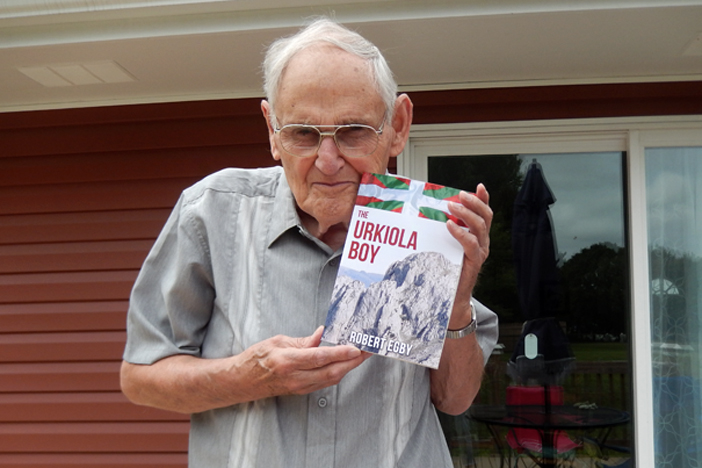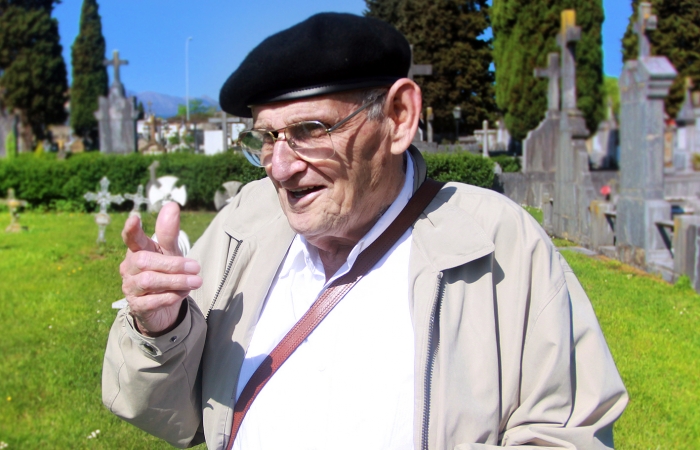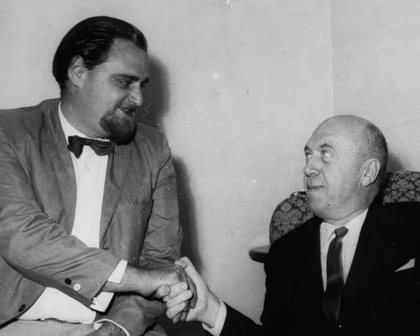«Durango is more picturesque than Gernika»
Robert Egby, an English author based in the United States, has recently published The Urkiola Boy, a historical novel that opens with the fascist bombing of Durango on March 31, 1937. Here we talk with the author.

Robert Egby in USA. PHOTO. Betty Lou
Is The Urkiola Boy a second part of For the love of Rose?
The Urkiola Boy is not a sequel. It does not follow-on. It is an off-shoot, in fact it runs parallel to For the Love of Rose during the bombing of Durango. Frank Barbury is carrying his injured sweetheart and sees the apparent lifeless body of a little girl, but he cannot help. That is Zoriona, Mikel’s sister. That is the root of The Urkiola Boy. Mikel comes and carries her to Frank’s ambulance.
Why did you choose Durango’s bombing as a historical episode to tell the world and not Gernika’s?
From the start, everyone knows Guernika. The bombing of Durango came first, a month ahead of Guernika. Durango is more picturesque. It has an incredibly beautiful background – the Urkiola Mountains and both together project some form of mysticism. When one walks the streets of Durango or the trails of the Urkiolas, one feels the presence of the ancient ancestors.
If Picasso painted Guernica, what painter could have painted a painting for Durango?
Francisco de Goya who painted the “Disasters of War.”
How many times have you visited Durango, Elgeta, …?
Four periods of one two to three weeks over five years.
Who is ‘The boy from Urkiola’?
A sniper.
In this book, you detail that it was the Italian aviation who bombarded Durango, not the German, as he slipped in For the love of Rose …
Most of the big historians of the bombing of Durango March 3lst 1937 credited the atrocity to the Luftwaffe’s Condor Legion and it was not until recently when Basque historians carried out extensive research that the bombing was shown to be the work of the Italian Air Force.
How did you receive that book in the United States?
Initial sales are moderate. Initial sales are doing well in the United Kingdom and among English-speaking Europeans. It is predominantly an “English” book while “For the Love of Rose” was “America” oriented.
In this new publication that can already be purchased by Amazon, I see that it also quotes ETA.
I did not quote the ETA – Euskadi Ta Askatasuna- because the novel takes place before in the years – 1936 to 1943. However, I did hint at its occurrence in the character of Jose Antonio, a radicalist inclined to terror activities who leaves the Mikel’s group. Jose was a symbol of the future.
How much of a novel and how much of a true story in The Urkiola Boy?
It is historical fiction overlaid on actual historical events. For instance at the start of the book, young Francisco Franco is in Cueta, Morocco, in October 1920, that is on record. He was told of his future by a soothsayer – that’s fiction. Another example: When Mikel is asked by the British to kill the assistant to Italian General Mario Berti at Sidi Barrani, Egypt – that was fiction. Berti was the General of 10th Italian Army at that time. He was fresh from the Spanish Civil War and the Aragon Offensive – that was fact. Winston Churchill and Roosevelt in Washington discussing the possibility Franco would let German forces through Gibraltar t o start a new front in North Africa. That was a fact.
You told me that he would like a Spanish version to be published. Also in Basque?
If the demand is there, I think the novel should be translated into Spanish. I think the translator must be Basque or someone with a knowledge of Euskal Herria.
In three years of effort he has learned to speak Spanish. A merit…
I have been studying the Spanish language for almost five years and while I could survive in a Spanish environment my problem is listening. It is the second fastest spoken language in the world.
The book makes no reference to you. Who is Robert Egby?
Some people say historical novelists do what they do because they like playing god. For me that is not correct. I like to create the characters from people I’ve seen, set the novel’s possible ending, and then let the characters work out their own way. For instance I didn’t want Mikel to make love to that young English girl Phillipa in Jerusalem, but when he did, the whole story took on a meaning of its own. It shocked me when Mikel reads the Jerusalem Post the next morning to and finds he has killed her father.
How do you remember your years as a war correspondent?
Reporters like the fighters and the women who stand and wait for loved ones to come home can never be forgotten. I recall the Suez War of 1956 as clearly as it happened yesterday. I was an accredited British War Correspondent. The faces of children who had lost fathers, the women searching the mountain of bodies outside the Port Said Cemetery. The Magnum photographer, still talking about the Spanish Civil War. Next morning he was killed by Egyptian soldiers.

Egby in Durango. PHOTO. I, Gorriti
You have done dowsing in the cemetery of Durango. What conclusions did you draw?
Anyone can dowse for water, earth energies, just as most people can see and hear. But people have limitations incurred by their cultures and fail to open their natural gifts. This is what Mikel, the Urkiola Boy was saying about the Basques. They have the ability to exercise gifts of healing and advanced learning and loving.
You met Otto Preminger. Because of their ‘fault’, they had to stop filming Exodus. Tell it …
Preminger was filming “Exodus” on Cyprus. The British authorities would not cooperate and lend him soldiers, so he had British expatriates and Greek Cypriots dressed as British soldiers as “extras.” When I visited the filming, I noticed one of the so-called “soldiers” was a Greek Cypriot fighter, a terrorist. He was smoking a cigarette. I took his photo and radioed it to my agency in London and next morning it was the front page on every London newspaper. Preminger stopped production for two days while he answered media questions. I told Preminger it was my photo. He asked me: “Do you want a part in my movie?” I immediately said “No. I am just a reporter doing a job.” Later, I wished I had accepted, but the offer was long gone. Two weeks later at a party at Government House he poked me and laughed. “Good story,” he said. I replied “Good movie.” He didn’t hold grudges.

Egby and Preminger.
How do you see the Basque people in matters of Culture?
The Basque Culture has a proud and ancient heritage. As my book explains they have a unique status in the world and in their origins. The problem is the world is developing and changing because of communication technologies. Forces, some of them very negative, infiltrate and undermine and devalue cultures to the point they may no longer stand as a unique status. The strength of the Basque Culture is in the language. It cannot be abused or changed by an advancing world.
We saw you dancing on the esplanade of the Guggenheim in a video that could go viral?
The musician was playing “Hello Dolly” when Betty Lou and I came out of the Museum. I started dancing, the musician stood right by me and Betty Lou took the video. A moment of joy caught in time.
Will you come to present the book to Durango?
Betty Lou and I plan to be in Durango on March 31st 2020. If I can find someone to translate the book into Spanish at a moderate price, I will publish it. If I can find a Basque or Spanish publisher who will take over the Spanish edition, that would be better. I am open to suggestions, always.
Etiquetas: Robert Egby, The Urkiola Boy






